
Digital marketing trends move fast. And sometimes those trends can change faster than any changes in your home performance, solar, or HVAC business. Chasing website design and UX/UI trends can sometimes feel like chasing rainbows, so what are the signs you can look out for to indicate that it’s time to bite the bullet and update your website?
At Energy Circle, we spend a lot of our time poring over the data from websites in our industries/of our clients, tweaking and optimizing to push for traffic, but more importantly for conversions. Here are 4 of the primary indicators that your website may be in need of a facelift, in order to better serve your customers.
Before You Look at the Numbers, Look at Your Website
The best place to start is to take inventory of your current site. There are a few questions to answer about the state of your content and design, and what will set your home performance, solar or HVAC business website up for success:
-
Is it easy to contact or get a quote on your current site?
-
How can someone find out if they need your services?
-
Are you providing some backstory?
-
Can a customer understand the economics of your services?
Look at your site through the eyes of a new visitor. What is your user experience? How many clicks does it take to get to a qualified form? It can be pretty easy to slip into “building science expert” mode, and click through a bunch of terms you may already be familiar with. But do your page titles and content speak to a regular homeowner?
The bottom line is that your website needs to make it easy for potential customers to accomplish three things:
-
Find You - This refers to both finding your website online (is it optimized for organic search, accessible to all types of people, responsive and functional on all types of devices, etc?) and finding your business’ physical location (are your name, address and phone number visible and consistent, is your site optimized for local SEO with resources like maps, city pages, and service area information?).
-
Understand You - This refers to both understanding what services and/or products you provide, as well as understanding who you are as a company and what sets you apart from your competition.
-
Contact You - This refers to the availability of contact information like your phone number and email address, as well as web forms and/or live chat functionality so users can select the option to reach you that they prefer.
What Can Be Adjusted?
When we look at the list of things you can change on your website, there are many ways to adjust your site, between design, content and functionality:
Content:
Refreshing content could be as subtle as updating some photos to make them more seasonally relevant, testing out some new CTA copy on your web forms, or incorporating more detail or semantically relevant keywords into the text on a few service pages. Content changes can also be more significant work, like adding new longform case studies or city pages, producing and publishing a custom video, or performing a deeper SEO audit and implementing more advanced optimizations to text and metadata.
Content Checklist:
√ Are your services are up to date?
√ Can your current content pages be enhanced or updated?
√ When was your last blog post?
√ Do you regularly add case studies and testimonials?
Design:
A design refresh can also be subtle, for example: updating the look of the navigation menus, or adding some stylized embellishments like promotion blocks or new iconography. It can also be a more comprehensive overhaul that involves a completely new theme.
Design Checklist:
√ Are you taking advantage of the whitespace/simplicity trend?
√ How current are your images?
√ Does your design prominently feature and enhance your content?
Functionality:
Functionality can be the trickiest upgrade to navigate if there are major enhancements or robust features you’re looking to add to your site. But it can be as simple as adding a pre-built plugin, module or widget from a third party that gives visitors a new capability they didn’t have before, therefore enhancing the value your site offers to its users.
Functionality Checklist:
√ Is live chat right for you yet? (If you’re not sure, you can get some answers here.)
Live chat and phones have started to eclipse web forms for quite some time now:
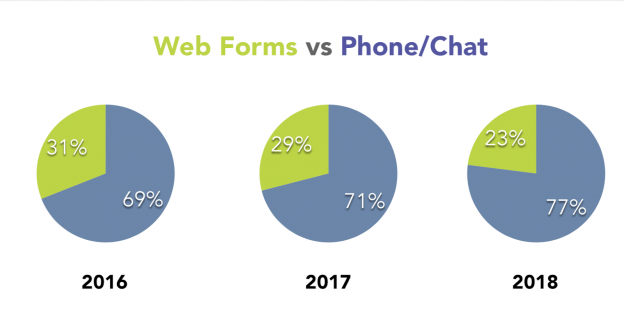
√ Can customers set an appointment directly on your site?
√ Are customers interacting with a savings (or solar) calculator?
1. Conversion Rates & Traffic
Taking a look under the hood, the right indicators will tell you a story about how your website is performing. Look at the highest performing pages on your site in your analytics. What are the trends you see in traffic, especially in relation to conversion rates?
Understanding Conversion Rates
Let’s make sure we all have a basic understanding of how conversion rates work. The equation is simple:
Leads / Traffic = Conversion Rate
Leads in this case are referring to phone calls, web form submissions, and/or completed live chat engagements that result in the collection of viable contact information from a potential customer.
Why does conversion rate matter so much? Because conversions translate to actual jobs. The below table represents data from an Energy Circle client in the Solar industry, and shows metrics from before and after their website was refreshed and optimized for lead gen conversion. In this instance, an uptick in conversion rate and number of leads (with no corresponding uptick in traffic) led to a $67,500 increase in revenue earned from the additional jobs.
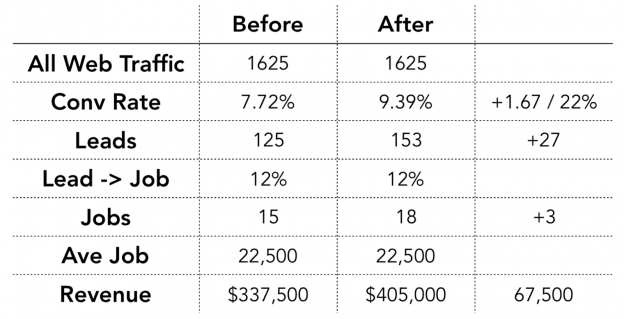
Here we see how optimizing a site for lead generation can correlate to a $67,500 increase in revenue.
What to look for: If your traffic has remained the same, but conversion rates have declined, you can assume that something about the user experience on your website is not working as well as it once did. The same number of people are visiting your site, but they’re not picking up the phone or submitting a web form as frequently as they used to.
So what changed? Perhaps users are no longer finding the content relevant or helpful. Maybe the aesthetic is dated, or it’s not working to effectively complement the content, so users are engaging with a competitor whose visual presence is more sophisticated. Don’t underestimate how paling in comparison to a competitor’s website can impact whether users interact with (and convert) on your website. In a fast changing digital landscape, a status quo can result in a decline in conversions, meaning it’s time to shake things up!
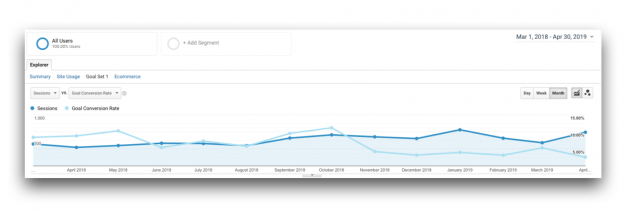
Status Quo = Decline in Conversion Rate: Screen shot from Google Analytics for a home performance company showing all sessions / traffic (dark blue line) and conversion rate (light blue line) data from Mar 2018 through April 2019. This company made no significant changes to the content, design or functionality of their website in the time frame shown and while traffic to the website increased slightly but generally remained consistent, conversion rate declined pretty significantly beginning in October 2018 and remained well below its average from the previous 6 month for the proceeding 6 months.
2. Keyword Ranking for Your Site
Another metric to evaluate when trying to determine if your website could use a refresh is the organic search performance of your site. More specifically, it’s important to regularly evaluate both the quality and the quantity of the terms and phrases for which your website shows up in organic search results.
The quantity of keywords for which your site ranks is a good measure of how comprehensive, and credible Google finds your website. Meaning, the more keywords your site pages rank for in general, the more valuable your brand is in Google’s eyes and so the higher your website will likely rank in organic search results. This will ultimately lead to more organic traffic to your site, and more opportunity for conversion. Not to mention — if your site shows up for a more diverse range of search terms, you’re able to reach a broader audience, building your brand awareness and improving your chances of capturing even more relevant leads.
So how many is enough? There’s no magic number that’s going to guarantee your website does or doesn’t need a refresh. Take some time to identify the most important service, product, and local search terms you know are a priority for your business and do some searching. How many of those important relevant terms return your site pages in the first page of organic results? How many are returning your competitor’s sites above your own? Have you lost any ground in terms of your rank and visibility? If you’re losing the game of organic search result domination, your website probably could use an update!
What keywords does your site rank for?
How can you know how many and which search terms your site pages are ranking for in organic search results? There are several tools — both free and paid — that can give you an idea of the quantity and quality of terms for which your pages are displaying. Google offers several free tools that offer some insight into SERP results and positions, like Search Console, Google Analytics and Google Rank Checker. SEM Rush, Accuranker and Ahrefs are three very robust paid subscription based solutions, but offer free trials.
3. How many different pages on your site rank for priority keywords?
When multiple pages rank for the same quality keyword, it signals to Google that your site is highly relevant for searchers looking for that particular service. Notice in the example below, there are 4 different pages from the same site that rank for search queries containing the keyword “energy audit”.
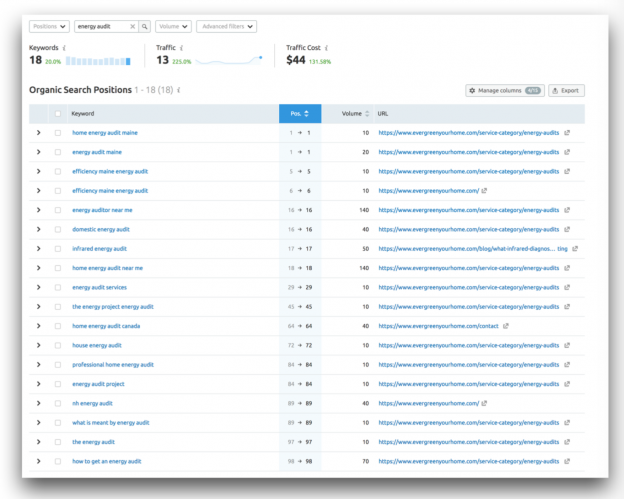
The more pages on your site that can rank for the same search terms, the more relevant your site appears to Google.
Not only is this site ranking for a good volume of diverse keywords, and therefore reaching a broader audience — it is also highly visible in the search results for individual, high priority service terms, making it more likely that a user will click on their website over a competitors’.
This begs a similar question as before: “How many different site pages should show up in the search results for priority queries?” Again, there’s no magic number. You want to dominate search results as much as possible. If your competitors have more links to pages on their site in search results than you do, they’re more likely to win those clicks and signal to Google that they have more useful content for those search terms on their site than you do.
We’ve said it before but it bears repeating: If you’re losing the game of organic search result domination, your website could probably use an update!
4. The Top Visited Pages vs The Top Converting Pages
Are your most visited pages the pages that also have the highest conversion rates? When it comes to traffic, your homepage is almost always going to win. But take a look at the traffic and the conversion rates on your other service pages. If you are seeing lower conversion rates on pages with higher traffic numbers, you may be missing an opportunity to leverage the popularity of those pages to drive more conversions. People are already going there; you just need to capture them! Investigate the conversion functionality, presentation and call-to-action messaging on those highly trafficked pages and identify improvements that will maintain the page’s popularity from a content perspective, but work better as a conversion tactic.
And – vice versa – if the site pages with the highest conversion rates are not also the pages with the most traffic, you are probably missing an opportunity there as well. When the data indicates that a page is working well as a conversion tactic, find ways in your marketing strategy to drive more traffic to it. Maybe the content needs to be updated to improve the pages rank and visibility in organic search results, or could an added feature or function make it more relevant to a broader audience?
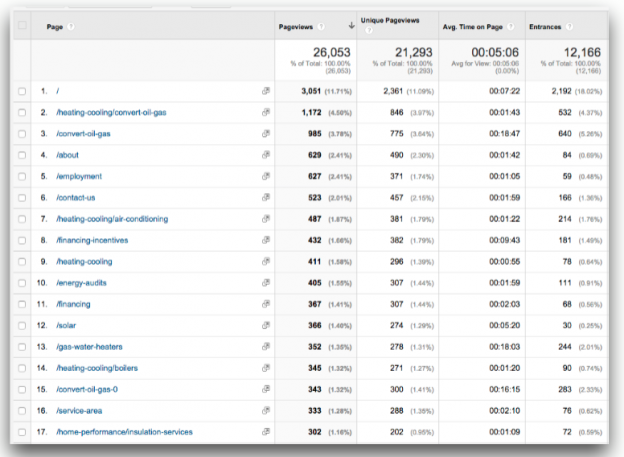
The "Site Content > All Pages" view in Google Analytics will tell you which pages of your site received the most views over a set period of time. Remember the stand-alone "/" references the home page of your site and is usually the most view page. Compare these metrics to the conversion rate data in the "Site Content > Landing Pages" view to determine if your most viewed pages are also your top converting pages, and vice versa.
The process of examining your most popular pages, and comparing them to your highest converting pages, can help hone in on the areas of your site that may need the most immediate help.
Set a Foundation for the Rest of Your Digital Marketing
Digital marketing is a revolving door of channels and functionality considerations. But at the end of the day, a well designed and accessible website lays the foundation for any and all of your other digital marketing efforts. Its where you will link any Facebook ad campaign, it’s where you’ll send any clicks from a PPC ad, and it’s what your potential customers will see when they do a local search for your services.